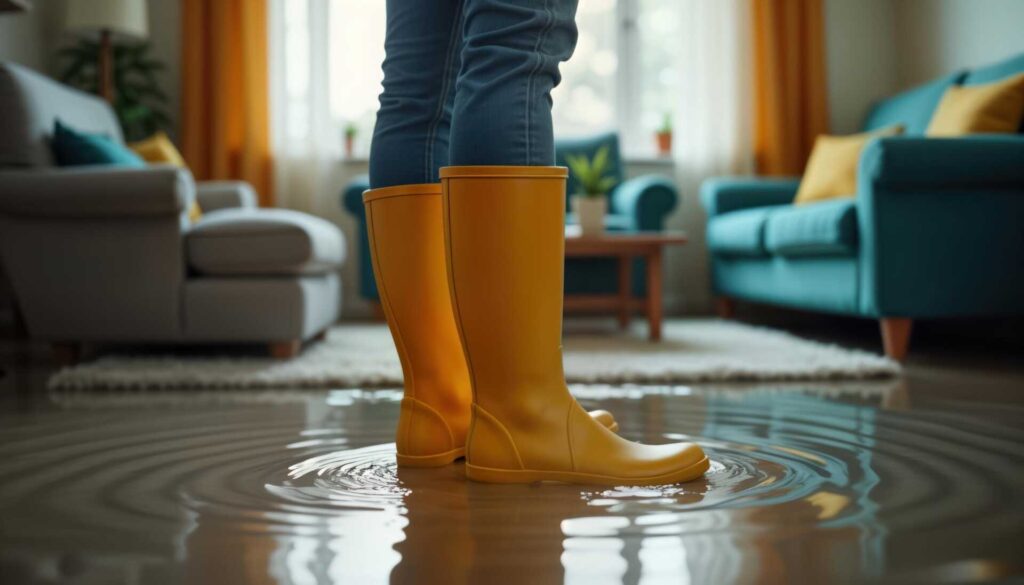
Contents
Imagine you return home after a heavy rainstorm to find your basement flooded. The situation requires immediate action to avoid further damage and potential mold growth. You’ll need to assess the damage and prioritize safety before starting the cleanup process. Understanding the right tools and techniques is vital for effective water extraction. Let’s explore five essential tips that will guide you through this challenging task efficiently.
Key Takeaways
- Inspect the area for structural vulnerabilities and ensure safety by wearing protective gear before starting the cleanup process.
- Use a wet/dry vacuum to remove standing water effectively, switching to a submersible pump for larger amounts of water.
- Open windows and use fans to enhance airflow while employing dehumidifiers to reduce moisture levels in the air.
- Lift carpets and vacuum underneath to prevent mold growth, ensuring all areas are thoroughly dried within 24-48 hours.
- Monitor humidity levels with a hygrometer, aiming for below 60% to inhibit mold development and maintain proper ventilation.
Assessing the Damage and Safety Precautions
Before you plunge into the water extraction cleanup, it’s crucial to assess the damage and take necessary safety precautions.
Start by inspecting affected areas for structural vulnerabilities, noting warped floors or damaged walls. Use a moisture meter to determine the extent of water saturation in materials. This data will guide your next steps and help you prioritize areas needing immediate attention.
Next, prioritize your safety by wearing protective gear. Don’t skip gloves, goggles, and masks to guard against contaminants and mold. If you detect electrical hazards, turn off the power supply before entering the area.
Assess air quality; if it seems compromised, ventilate the space adequately.
Document your findings with photos and notes, as this might help with insurance claims later. These steps safeguard your well-being and lay a solid foundation for effective cleanup, fostering a sense of control and belonging in recovery.
Gathering Essential Tools and Equipment
Once you’ve assessed the damage and confirmed a safe working environment, it’s time to gather the tools and equipment necessary for effective water extraction cleanup. Having the right gear on hand streamlines your efforts and enhances safety and efficiency.
Here’s a quick reference table for essential tools:
| Tool/Equipment | Purpose |
|---|---|
| Wet/Dry Vacuum | Extracts standing water |
| Squeegee | Removes excess water from surfaces |
| Dehumidifier | Reduces moisture levels in the air |
| Protective Gear | Ensures safety during cleanup |
Make sure to collect these items before starting your cleanup. This preparation boosts your confidence and fosters a sense of community as you’re taking proactive steps to restore your space. With the right tools, you’re well on your way to managing the water extraction process effectively.
Removing Standing Water Efficiently
As you begin the water extraction process, efficiently removing standing water is essential to prevent further damage and mold growth.
Start by evaluating the area to identify the depth and extent of the water. For small amounts, use a wet/dry vacuum, ensuring you have the right attachments for maximum suction.
For larger pools, consider a submersible pump for quicker extraction. Position the pump at the lowest point to facilitate drainage.
Always monitor the water level to switch out containers or adjust the pump as needed. If you encounter debris, use a rake or a skimmer to clear it away, as this will enhance the efficiency of your extraction tools.
Once you’ve removed the bulk of the water, check for any hidden pockets that may require additional attention.
Stay methodical and thorough—every drop counts in your efforts to protect your space from long-term damage.
Drying Out Affected Areas
After effectively removing standing water, the next step is drying out affected areas to minimize moisture retention and prevent mold growth.
Start by opening windows and doors to enhance airflow. Use fans strategically; place them in the affected areas to circulate air. Dehumidifiers are essential—set them to the highest setting to extract moisture from the air.
For carpets, lift them and use a wet/dry vacuum to remove any remaining moisture underneath. If possible, remove the baseboards to allow better airflow and drying.
Check hidden spaces like closets or under furniture, as these areas can trap moisture. Monitor humidity levels with a hygrometer; aim for a reading below 60%.
It’s vital to keep these areas dry for at least 48 hours. Regularly inspect for any signs of dampness.
Preventing Mold Growth After Cleanup
To effectively prevent mold growth after cleanup, you need to maintain a dry environment, as mold thrives in moisture-rich conditions.
Start by ensuring all affected areas are thoroughly dried within 24-48 hours. Use fans, dehumidifiers, and open windows to circulate air. Monitor humidity levels, aiming for below 60%.
Next, inspect and seal any cracks or crevices in walls and foundations where moisture can enter. If you’ve cleaned porous materials, consider treating them with a mold-resistant solution.
Regularly check for leaks in plumbing and roofs, addressing issues promptly. Additionally, maintain proper ventilation in bathrooms and kitchens to reduce humidity.
Finally, consider using moisture-absorbing materials like silica gel in storage areas.
Recap
By following these five DIY tips, you can turn a challenging situation into a manageable task. With careful assessment, proper tools, and efficient water removal, you’ll create a dry, welcoming environment. Don’t forget to keep an eye on humidity levels to safeguard against any uninvited guests like mold. Embrace the process, and you’ll restore your space and gain peace of mind, knowing you’ve taken the right steps to ensure a healthy home.
Recent Posts
Your Trusted Guide to Flood Damage Repair
It’s essential to act quickly and methodically to mitigate any further issues from flood damage.
Comprehensive Flood Damage Repair Process Explained
Flood damage repair can seem like an insurmountable task, but it’s important to tackle it
What Is the Step-by-Step Flood Damage Repair Process?
When you face flood damage, evaluating the damage, extracting water, and drying the area are
